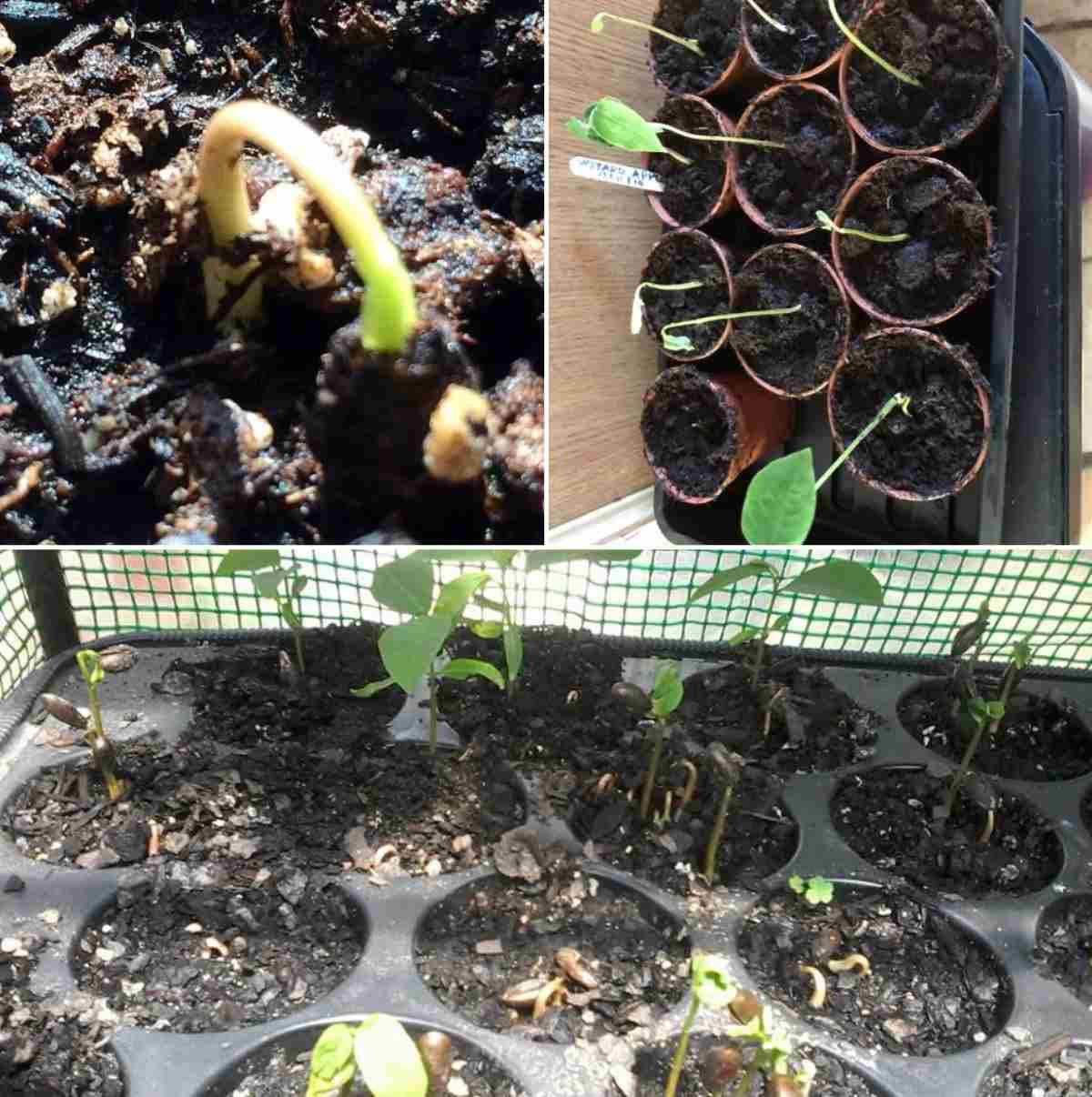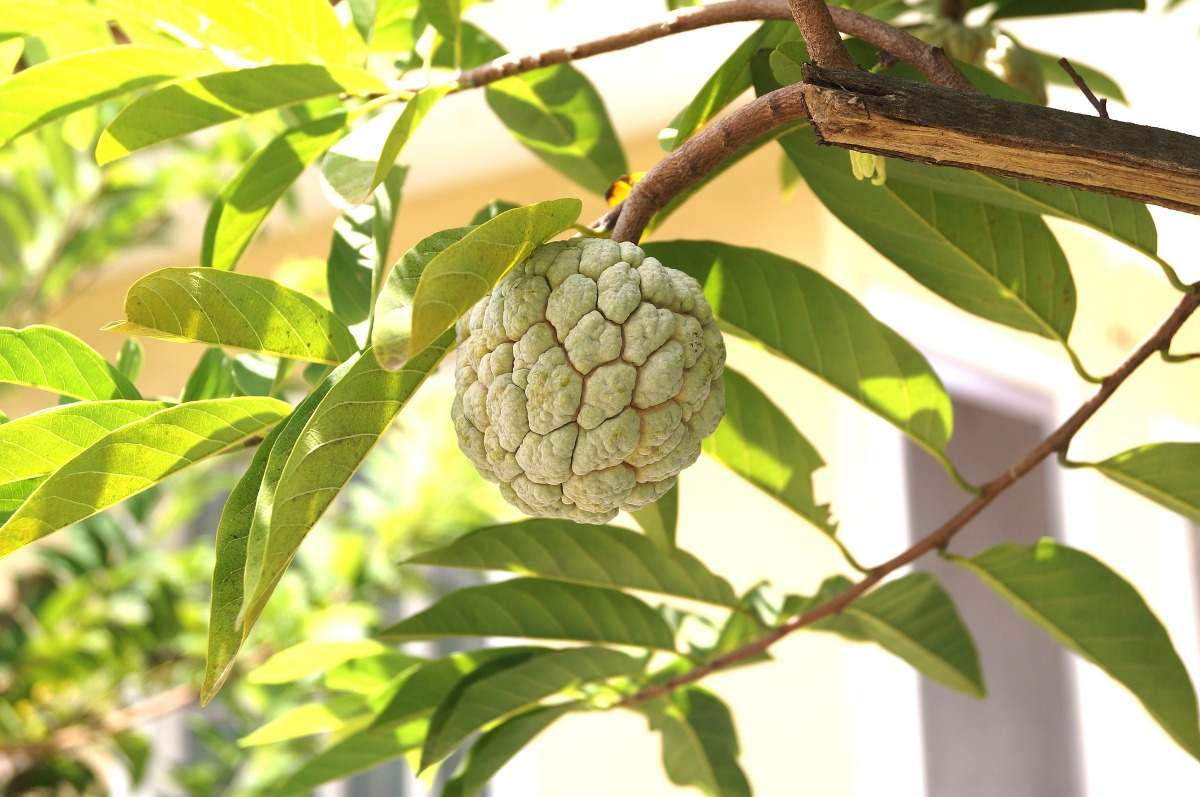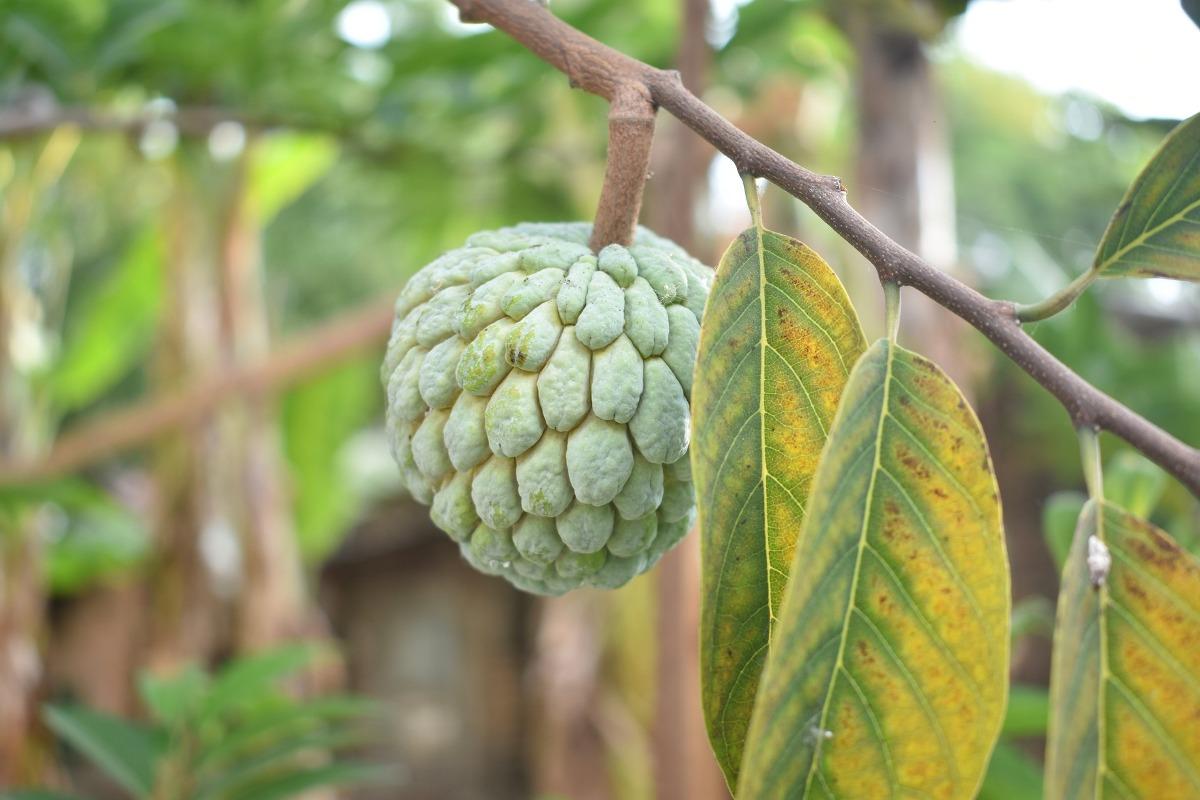Introduction to Custard apple seed germination: Custard apples are deliciously sweet sub-tropical fruit. The Custard apple is also called sugar apple or cherimoya. Custard apple ( Annuna squmos L.) fruit is one of the finest fruits introduced in India from tropical America. It is found in the wild form in many parts of India. Custard apple is cultivated in Andhra Pradesh, Maharashtra, Karnataka, Bihar, Orissa, Assam, and Tamil Nadu. Besides India, Custard apple is common in China, the Philippines, Egypt, and Central Africa.
In this article we also discussed below topics;
- Process of growing Custard apple from seed
- Time to take Custard apple seeds take to germinate
- How do you germinate Custard apple seeds
- Custard apple seed germination temperature
- Process for germinating Custard apple seeds
- Custard apple seeds germination period
- Tips for Custard apple seeds germination
A step by step guide to Custard apple seed germination
Custard apple trees are large and spreading, shaded by large, green drooping plant leaves. Custard apple trees are attractive fruits grown in tropical areas. The Custard apple tree is spherical spreading; it has a different crown in 10 to 14 centimeters thick trunk. Its height is 15 to 35 feet, and plant leaves have a special type of fragrance, they are deciduous, and narrow, which is 4 to 8 inches long. It is found in different sizes and colors; it is made in spherical and also conical, made of knobby segments with a thick hole. The size of the fruit is 4 to 6 inches.

Different varieties of Custard apple
There are mainly two varieties of Custard apples, the Pinks Mammoth and African Pride. Both varieties are sweet, juicy and full of flavor.
Pinks Mammoth – As the name suggests, the Pinks Mammoth is the larger of the two varieties. It can produce up to 3kg and has yellow-pink coloring between the ridges of the bumps when mature. You can pull a Pinks Mammoth apart with hands and then scoop out the flesh to enjoy.
African Pride – The African Pride is the smaller variety and medium-sized usually between 500g-800g.
Both varieties have a full appearance when mature, and skin will start to smooth out the bumps. They turn from dark green to light green.
Propagation of Custard apple
The Custard apples are commonly propagated by seeds. Some techniques in vegetative methods and budding can be adopted for multiplication. The seedlings of local Custard apple have proved a good rootstock for several improved varieties and hybrids. Seeds treated with 100 ppm for 24 hours germinate quickly.
You should not miss the Food Processing Subsidy, Loan.
Custard apples seed collection
Break open the Custard apple and pick through the flesh to find the seeds. Any flesh that clings to the Custard apple seeds needs to be washed off to avoid rot. After washing them, put them on several layers of paper towels to dry completely and then store them in a glass jar until you want to plant them. Custard apple tree seeds germinate better when they are a week old than when fresh from the fruit.
Soil and container for Custard apple seed germination
The entire process of Custard apple seed germination can be likened to a fungal pathogen magnet. With moist soil and tender plant tissue, avoiding fungal infections is the challenging aspect of propagation with seeds. If you will be reusing old germination containers, sterilize them in a solution of about 1 part household bleach and 9 parts of water. Allow the container to soak for about 15 to 20 minutes and rinse well afterward. Use a soilless germination mix, obtainable at most large gardening centers, to further protect the seeds from the disease. Fill the container to within ½ inch of the rim and moisten it thoroughly before planting the Custard apple seeds.
Seeds preparation for germination
The Custard apple seeds are very hard, so they need some preparation before sowing. The success of growing Custard apple from seeds depends greatly on proper seed preparation before sowing as the seeds are hard. The seed is mainly prepared by soaking in water. Collect large size seeds from a very sweet Custard apple bought from a grocery store.
Then soaked the seeds in water in a cup at room temperature for 4 days. On the 5th day, took out the seeds were sitting at the bottom of the cup and placed them on a paper towel to air dry. And threw away the Custard apple floating seeds, which are not good for germination.
Custard apple seeds may take 30 days or longer to germinate. Speeding up the germination process is possible, but it cuts down on the percentage of seeds that will germinate. If you opt to accelerate the germination process, treat the seeds before planting by either soaking them in room-temperature water for 3 days or by scarifying them.
Sowing requirement for Custard-apple
Better in peat soil with vermiculite possible in other soils, take care that soil will be well ventilated. Conditions for Custard apple seed germination will be moist soil, sunny location, and water regularly, and don’t let it dry.
How to sow Custard apple seeds
Take a pot and fill it with well-draining soil. You can use a seed raising soil or make your own. Sow the seeds about 1 inch deep keeping 2-inch separation between them. Mixed potting mix with river sand in equal amount and filled the pot, leaving top 1 inch empty. Placed the seeds on the soil and fill the pot with the soil.
Water well and locate the pot in indirect sunlight. Keep the soil damp as the seeds germination needs a humid and warm environment.
The Custard apple seeds germinate quickly (about 3 weeks) in the temperature range between 18 and 25°C (64 and 77°F). When the seedlings grow to a height of 3 to 4 inches, it is time to transplant them.
Growing Custard apple from seed
Custard apple seeds are harsh, therefore before planting their seeds, soak the seeds in water and leave them for 3 days. This gives you success in the seed germination process. And after leaving the seed put it in a blotting paper or towel.
In case if you miss this: Management of Plant Viral Diseases.

Before planting the seeds, make a good drainage hole in the pot. Fill with the prepared soil in this pot or use the Potting Mix. Then mix sand and compost in a small quantity with soil. After filling the soil, put seeds in different places with a depth of 1 inch. After that, pour water into the pot and keep the pot in direct sunlight. Keep the soil moist, because seed germination requires warm and humid environments. Custard Apple seeds germinate very rapidly in 18 to 30C. It takes about 3 weeks to germinate. When the plant grows up to 3 to 4 inches, then the transplant grows Custard apple from a seedling.
Growing sugar apple from seedling can take some time and requires transplanting but it is better than growing sugar apple from seeds. For seedlings, you should start by wrapping seeds in a paper towel, then soak them in water and place them in a zip lock bag to soak for at least 3 days. Otherwise, you can scarify the seeds with sandpaper and soak them in water for a whole day.
For the seeds to germinate, they require good quality soil and a sunny spot. Sugar apple seeds love warmth and light. If you can’t provide enough sunlight for seeds, consider installing grow lights. The container you use for seedling must be at least three inches deep. Then fill it with soil and make sure that the soil is moist and damp. Then plant the seeds 3 cm deep in the soil and water the seeds carefully. Custard apple seeds like moist soil but not waterlogged soil. So, you should let the soil dry before you water it again.
Once the seedlings are mature you can transplant them outside in our garden or a bigger pot. Custard apple fruit can grow in pots if you choose the right variety. The best Custard apple varieties to grow in pots have Seedless Cuban, Balangar, and mammoth. If you are going to transplant the seedlings in the garden, make sure to do it during a warm climate. These plants can tolerate drought to a certain extent but they cannot tolerate coldness at all. They need a temperature degree above 50F so make sure you do the transplanting in spring or summer in a sunny area.
Transplanting the Custard apple seedlings
Tap the pot from all sides to make the soil loose and take out the saplings carefully without damaging the plant roots.
Plant the saplings in a pot filled with well-draining soil. Then make the soil by adding river sand (25%) and compost (25%) in potting mix (50%). Put the planted pot in indirect sunlight for at least 4 weeks, or until the root system is strong enough to transplant the tree to its permanent position.
If growing in a pot, do not plant the sapling in a large pot. Start with a small pot and then transfer to the next pot size when the roots start to emerge from the bottom holes of the pot. This way the plant will be always in fresh soil getting the required nutrients. Then, put the pots in a warm position protected from winds.
Custard apple plant care
Custard apple trees prefer deep, rich soil, which is sufficient humid and good drainage. It flourishes in tropical areas and different types of soil. It grows in the wild terrain, but it gives relatively less production.
This Custard apple plant requires regular water, especially at the time when the plant is growing actively and the flowers are growing. Due to less water, the fruit can burn directly in the sunlight, and over-watering can rot in the plant roots. In winter, when the tree becomes dormant, it does not need regular water.
You may also like the Subsidy for Composting, Organic Farming.
A Custard apple tree grows very rapidly if there are dry weather and growing period; good results are obtained from mulching, organic manure, and regular watering. To improve the number of fruits, then you can pollinate flowers by hand every morning. For this purpose, you can brush the male flowers from the thin paintbrush and pollen it in the center of the female flowers.
Maintaining plant health and vigor manuring is very important. The trees are the application of manure and fertilizers are improving the vigor, yield, and fruit quality.
Watering Custard apple plants
Water regularly when the Custard apple trees are actively growing and flowering. Irrigation to plants during flowering and fruit development is necessary. Though, in the absence of water harvesting in the post-monsoon period, 2 or 3 irrigations help in a better quality of fruits and higher production. The fruit set, yield per plant, and quality are superior in irrigated plants with more edible pulp or segment. Custard apple plants receiving regular water grow luxuriantly with each bearing. Pruning, fertilization, and irrigation are essential to get maximum yield.
Underwatering the Custard apple tree can cause the fruit to burn in direct sunlight, while over-watering can lead to root rot. During the winter, when the tree becomes dormant, they do not need regular watering. Mulch and prune tree in spring to open vase shape. Fertilize well after fruit set with organic fertilizer and regular watering commencing at flowering to harvest is important.
Pests and diseases of the Custard apple plant
Custard apple is not serious pests and diseases so you can get rid of them with limited chemical use. Aphids and mealy worms can damage this Custard apple tree, which can control without any chemicals. Though the Custard apple crop is hardy, it suffers from pests. They are Mealybug, Scale insects, Fruit boring caterpillar, Leaf spot, Anthracnose, Black stone, spraying with neem oil, Meenark, and some herbal preparation is recommended.
Custard apple harvesting
Fruits take up to 6 months to mature on the tree after setting. Though, one thing to look for is the skin between the main segments of the fruit, which changes from a green to a cream color. Cut the fruit stem with a pair of secateurs, leaving a 3 to 5cm stub of stem on the Custard apple fruit. This mainly helps to prevent the entry of disease spores. The Custard apple fruit now needs to be left for a couple of days at room temperature to soften before it is ready to eat.
Some questions about Custard apple farming and seed germination

How can you tell when a Custard apple is ripe?
A Custard apple fruit is ripe if it gives slightly when gently pressed. Custard apple fruits can be bought ready to eat, or still hard to the touch. If, allow to ripen over several days before eating. To speed ripening, then put the fruit into a brown paper bag with a banana and leave it on the kitchen bench.
How long does it take for Custard apple seeds to germinate?
Custard apple seeds have a relatively long life, having kept well for 3 to 4 years. The seed germinates better a week after removal from the fruit than when perfectly fresh. Germination can take 30 days or more but can be hastened by soaking for 3 days or by scarifying.
How long does it take for a Custard apple tree to bear fruit?
Seedling Custard apples do not produce satisfactory fruit and they take many years to produce any fruit at all. As such they are an unreliable proposition for the gardener and the commercial grower. Grafted trees bear within about 3 years from planting and the fruit is much superior to that of the seedlings.
Is Custard apple self-pollinating?
Custard apple trees are self-pollinated. Self-Pollinating means trees that do not need another to complete the pollination process.
How big do sugar apple trees get?
Sugar apples are also known as Custard apples. This Sugar apple fruit tree reaches 10 to 20 feet tall, producing 3-inch-long, green, heart-shaped fruit covered in bumps.
Why do Custard apples go black?
Infection begins at blossom-end of the Custard apple fruit and later spreads on the entire fruit surface, affected fruits shrivel and they may cling to the tree or fall. Necrotic spots of 2 to 10 mm in diameter appear on unripe fruits which turn into dark brown to black spots.
Can you grow Custard apples in the UK?
Custard Apple is relatively well-known for its fruits but rarely seen in the UK as a plant. In the UK, this means growing it in an ornamental container outside during the warmer months and bringing it indoors for the winter season.
Are Custard apple seeds toxic?
The Custard apple seeds are so hard that they may be swallowed whole with no ill effects but the kernels are very toxic. The Custard apple seeds, leaves and young fruits are insecticidal.
Conclusion of Custard apple seed germination
You may apply this seed germination information for growing custard apple or Sitaphal in the polyhouse, greenhouse, nursery, backyards, containers/pots, and even in the backyard. You may be interested in Kale Seed Germination, Temperature, Times, Process.
Very informative… Just what I need to know about the custard apple….. I’m searching the internet for online sales for custard apple……